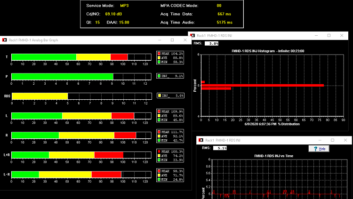One of the most compelling features of digital radio systems is the ability to complement audio programming with real-time delivery of text and other information on a receiver display.
This programmatic metadata, generally known as Program Associated Data, can range from basic song title and artist information to news headlines, detailed background information and even album art or other images, if the receiver display supports it.
That’s the promise. Realizing the full potential of this capability, however, will require a rethinking of broadcasters’ role as information providers.
Not just audio
Until now, radio has essentially been an audio-only medium. Aside from some limited experimentation with RBDS and Internet streaming, most radio broadcasters in the United States haven’t had much experience in managing data for end-user distribution.
With the advent of satellite radio, iTunes and other digital audio services, however, users have come to expect metadata as an integral part of the listening experience. Receiver manufacturers have responded by incorporating enhanced data display capabilities into many of their home and automotive products.
As this trend continues, radio broadcasts that lack data services will be perceived less favorably by users choosing between audio programming on display-centric devices.
The challenge for radio in this competitive environment is to find ways to deliver high-quality PAD alongside one or more audio channels, while keeping costs low by integrating data management tasks within existing production and distribution workflows.
For the chief engineer or operations manager charged with implementing his or her station’s PAD strategy, the simple goal of getting text onto a display can seem both simple and complex at the same time. A few fundamental principles will help to guide this process.
1. Do the Best With What You Have
Pick the low-hanging fruit first. Most music stations on the air with HD Radio PAD have figured out quick and inexpensive ways to tap into their automation systems to forward current song title and artist information.
They accomplish this either through RDS/RBDS features included in the systems, add-on data management packages, custom data utilities, or by piggybacking onto data services designed to forward information to their station Web site.
News and talk stations have used the same methods to deliver program title and host metadata from automation playout schedules or simple tabular data files. Stations that play music directly from CDs and vinyl have re-purposed their logging or Web site playlist tools.
The advantage of this approach is that it’s an easy and fairly inexpensive way to get text onto receiver displays; the disadvantage is that you’re often tapping a data source that was never intended to be used by anyone outside the station, so data quality and consistency can be a problem.
It’s wise to review your data source for any obvious misspellings, errors or missing fields in the metadata before you begin to broadcast PAD.
2. Focus on the User Experience
Once you have a basic data service running, assemble a sampling of several common HD and RBDS-capable receivers from different manufacturers to monitor the results from a listener’s point of view.
Over the course of a few days, you should be able to identify patterns of any discrepancies or unexpected display behavior across the various models.
At this point, you’ll have to refine your source data to resolve or alleviate any problems caused by the constraints of current receiver displays. For example, “Symphony in Bb” may need to be changed to “Symphony in B-flat” to ensure that listeners do not see “SYMPHONY IN BB” on receivers that can only display uppercase letters.
Balancing the requirements of PAD display with the needs of system users in the station can be tricky, however. Artist or song title fields may have been formatted to speed searches for specific cuts in alphabetical lists, so you may not be able to change “Beatles, The” even though it’s not ideal on a receiver display.
If your system allows you the flexibility, you could resolve this conflict by adding or repurposing additional data fields for each title to use for display-only artist or title information and export those fields for PAD use, leaving your primary fields unchanged for station users.
3. Build From the Basics
Once you’ve successfully launched a working data service, it’s time to review your data requirements and begin to build out the capabilities to deliver consistent PAD across your program schedule and to support the metadata requirements of other forms of digital media.
As you determine what data you’d like to display during morning shows, talk shows, newscasts, network programs and during commercial breaks, the complexity of ingesting, managing and distributing all of the information required may seem a bit daunting.
Best Practices for Data System Design
- Measure progress through frequent monitoring of data services on multiple devices
- Agree on house standards for content, style, and presentation
- Build quality control into the workflow; not just at the end
- Keep it simple for users
- Assume nothing is given; ask “Why?”
- Build in “value adds” that reward users for adopting change
- Make it scalable
- Test, retest and refine
The good news is that the raw material for a rich data service already exists. Show prep material, production notes, scripts, guest bios, promo copy and detailed broadcast schedule information from traffic or automation systems are valuable and easily accessible sources of metadata. The problem is that it’s most likely spread throughout the facility, in many different formats, and with huge variation in quality.
Ideally, the tools to manage these disparate sources of information would be built into our production, scheduling and automation software, but since this hasn’t been a high priority for most U.S. broadcasters, manufacturers haven’t included such features into their products.
This means that to implement your requirements, you may need to link several systems together or even do some custom development in-house.
Information architecture and management are not traditionally core areas of experience for broadcast engineers, so you may want to partner with your in-house or contracted Web developers, since they are particularly skilled in deploying flexible, high-availability data management systems.
4. Become a Workflow Guru
The technical challenges of building a robust and scalable metadata system are fairly straightforward; it’s the organizational and workflow changes that are required to make such systems work well that are far more difficult.
Since programmatic metadata essentially is a “new” service for broadcasters, we simply haven’t built into our internal information processes the editorial, quality control and management structures that are required to ensure a consistently high-quality data service for end users.
There’s no easy answer for this; changing the inertia of long-established processes takes a lot of energy, and it’s most difficult when the reason for the change is perceived as a new external requirement.
As you start to dig into your station’s existing information management workflows to determine how to best capture and distribute metadata, look for ways to partner with internal users to make their jobs easier as you introduce changes.
For example, installing a new newsroom management system with enhanced data management capabilities as well as more powerful assignment and scheduling tools will allow editors and reporters to see tangible improvements in their day-to-day work, reducing resistance to changes in established procedures.
Conclusion
The process of workflow improvement is by its nature iterative. A constant loop of tests, review and refinement is required to develop systems that match the service requirements, resources and capabilities of your station.
Although developing and implementing a comprehensive metadata management system to support digital broadcasting and other metadata-rich distribution technologies do require a significant investment in time and commitment to change, broadcasting organizations who make the effort will be best positioned to leverage the value of their creative assets in the competitive digital media future.











